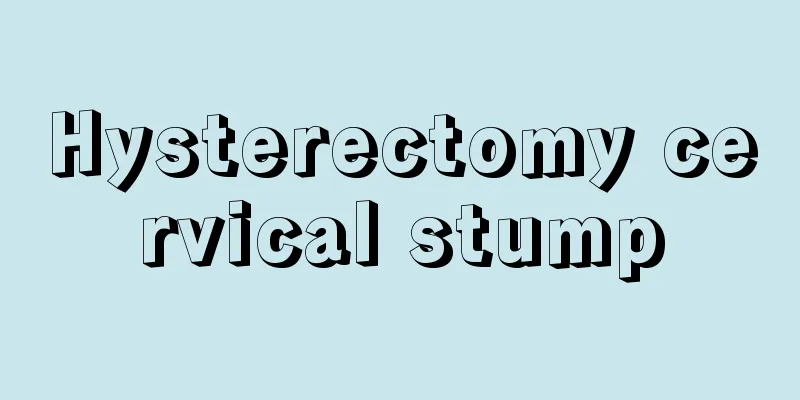Hysterectomy cervical stump

|
Cervical stump cancer refers to lesions in the remaining cervix 2 years or more after subtotal hysterectomy. There are two types of cervical stump cancer: one is the existing lesions in the cervix before subtotal hysterectomy, and the development trend within 2 years after the operation, which is called "coexistent stump cancer"; the other is the absence of lesions at the time of subtotal hysterectomy, but the development after the operation, which is called "pathological stump cancer". The stump cancer specifically referred to here is the latter type. Although the incidence of cervical stump cancer is lower than that of general cervical cancer, it is more difficult to treat and more complicated to deal with. Therefore, it should be given more attention in clinical medical work. Tumor radiotherapy is the main method for treating cervical stump cancer. It is suitable even for patients with early stage disease. However, corresponding treatment measures should be formulated according to the stage of the tumor, the size of the tumor and the changes in the anatomical structure of the cervical canal. For patients with small tumors, short neck canals and minor anatomical changes, intracavitary treatment is more effective; for patients with large tumors, short neck canals and major anatomical changes, direct external radiation is more effective; for patients with exophytic tumors and heavy bleeding, vaginal catheter radiotherapy and chemotherapy are given. Because the cervical canal cavity of cervical stump cancer is generally very short, it is not conducive to intracavitary tumor radiotherapy, and the distribution of pelvic injection is not ideal. Therefore, in recent years, there has been a tendency to use extracorporeal tumor radiotherapy of 4000-5000CGy, and then whether radioactive substances can be injected for treatment depending on whether the length of the cervical canal cavity is more than 2.5cm. Those who can inject radioactive materials can undergo intracavitary radiotherapy, but the usage of point "A" is low; if radioactive materials cannot be injected into the cervical canal cavity, extracorporeal radiotherapy can be used, but the radioactive field should be reduced or intracavitary radiotherapy with an ovoid applicator placed in the vaginal vault can be used as the main approach. In addition, if surgery reveals metastasis of pelvic lymph nodes, additional external radiotherapy and chemotherapy should be performed. Because patients with cervical stump cancer have no uterus, the distance from the cervix to the duodenum is shortened, and the thickness of the protective layer (uterus) between the sigmoid colon and bladder and the radiosource in the cervical canal has disappeared. Therefore, the chemoradiotherapy complication rate of cervical stump cancer is higher than that of general cervical cancer. According to statistics from foreign materials, the complication rate of cervical stump cancer is 31%, while that of cervical cancer is 8%. The specific manifestations are symptoms of radiation cystitis and radiation proctitis, namely: frequent urination, urgency, inability to hold urine, painful urination and hematuria; persistent diarrhea, bloody stools, intestinal adhesion ulcers, intestinal stenosis, rectal vaginal fistula, etc. |
<<: What causes female adnexal cysts?
>>: What causes acute urethritis in women?
Recommend
Can pregnant women eat lettuce?
There are many delicious foods that will suit man...
Diet care for spontaneous abortion bleeding for a few days
In today's society, spontaneous abortion is s...
Are weight loss vomiting tubes for sale? Exposing the dangers behind vomiting
At the end of last year, a piece of news about #b...
Normal value of human villus after abortion
Many people who have miscarriages choose painless...
How to eat hot pot when wearing contact lenses? Eating hot pot will not melt the contact lenses?
Generally speaking, there are basically three cat...
Can pregnant women eat some coriander?
Coriander is a relatively common green vegetable....
Is it okay for pregnant women to eat fresh walnuts?
Fresh walnuts are rich in nutrients and have cert...
Be careful! 80% of people are diagnosed with gastric cancer at an advanced stage. Are you one of them?
Gastric cancer is the third most common cancer in...
Is it normal to have little fetal movement in the 6th month of pregnancy?
If we find that the fetal movement is relatively ...
How to make tiger skin plant bloom? How long does tiger skin plant bloom?
Tiger skin plant is easy to care for, ornamental,...
What is the reason for yellow watery vaginal discharge?
Leucorrhea is no stranger to female friends. It i...
Is second degree cervical erosion serious?
The second degree of cervical erosion is in the m...
After COVID-19, I "felt stupider". Do you also have "brain fog"? How to relieve it? See here!
Recently, some patients said that they felt tired...









